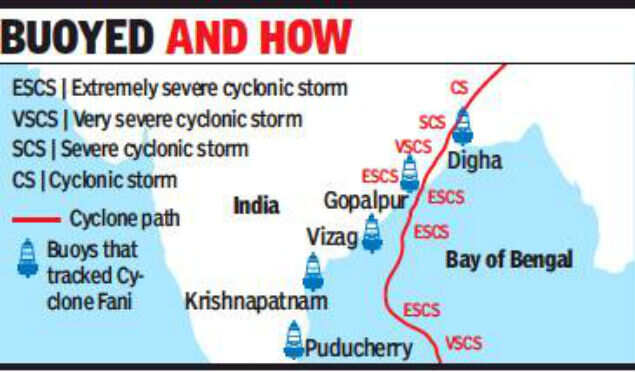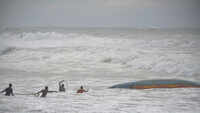
CHENNAI: Days before Cyclone Fani formed and made landfall, tiny yellow floating buoys on the sea sensed a storm was brewing. Nearly 12 buoys deployed along the east coast and deep in the ocean withstood Fani’s onslaught and helped save hundreds of lives both on land and at sea, as they assisted meteorologists in tracking movement of the cyclone in real time and estimate its path.
More than 1.2million people were evacuated in Odisha before the extremely severe cyclonic storm made landfall, as buoys along the coast recorded winds gusting at 190kmph and waves reaching a height of 6.3m. These floating devices also played a key role in forecasting the cyclone’s shift in course. Seven of the buoys along the coast were deployed by Hyderabad-based Indian National Centre for Ocean Information Services (INCOIS) and five far into the sea by National Institute of Ocean Technology.

According to experts, nearly a week ago, sensors in a wave rider buoy anchored about 1,140km from Chennai and parallel to Sri Lankan coast first recorded unusual sea conditions when a deep depression crossed at about 36km away. The atmospheric pressure suddenly dropped, and winds gusted at 18.7m per second.
NIOT director M A Atmanand said it was the buoy anchored at 425km from Chennai that came in direct contact with the cyclone on April 30. Atmospheric pressure at mean sea level dropped from 1010hPa to 980hPa as wind speeds rose from 5m per second to 28m per second. It was here that the highest wave was recorded at 6.8m. “It had intensified into a cyclone by then and almost hit our buoy,” he said.
Buoys both along the coast and deep in the sea recorded several parameters, including temperature, atmospheric pressure, wave height and direction, wind speed and direction and sea surface temperature. “Buoys captured high levels of heat in the upper ocean in central Bay of Bengal. This heat usually works as an energy source for storms,” said R Venkatesan, head, Ocean Observation Systems, NIOT.
Data from the buoys was received every 30 minutes and disseminated after processing to various departments, including IMD, Coast Guard, Navy, fishermen associations, NDRF, tourism boards and coastal state governments. Balakrishnan Nair T M, head of Ocean Science and Information Services Group, INCOIS, said during landfall, the waves rose to a height of about 6.3m along Odisha coast as winds gusted at 190kmph near Puri. “Our buoys near Vishakapatnam, Gopalpur and Digha withstood the storm and kept sending data continuously,” he said.
More than 1.2million people were evacuated in Odisha before the extremely severe cyclonic storm made landfall, as buoys along the coast recorded winds gusting at 190kmph and waves reaching a height of 6.3m. These floating devices also played a key role in forecasting the cyclone’s shift in course. Seven of the buoys along the coast were deployed by Hyderabad-based Indian National Centre for Ocean Information Services (INCOIS) and five far into the sea by National Institute of Ocean Technology.

According to experts, nearly a week ago, sensors in a wave rider buoy anchored about 1,140km from Chennai and parallel to Sri Lankan coast first recorded unusual sea conditions when a deep depression crossed at about 36km away. The atmospheric pressure suddenly dropped, and winds gusted at 18.7m per second.
NIOT director M A Atmanand said it was the buoy anchored at 425km from Chennai that came in direct contact with the cyclone on April 30. Atmospheric pressure at mean sea level dropped from 1010hPa to 980hPa as wind speeds rose from 5m per second to 28m per second. It was here that the highest wave was recorded at 6.8m. “It had intensified into a cyclone by then and almost hit our buoy,” he said.
Buoys both along the coast and deep in the sea recorded several parameters, including temperature, atmospheric pressure, wave height and direction, wind speed and direction and sea surface temperature. “Buoys captured high levels of heat in the upper ocean in central Bay of Bengal. This heat usually works as an energy source for storms,” said R Venkatesan, head, Ocean Observation Systems, NIOT.
Data from the buoys was received every 30 minutes and disseminated after processing to various departments, including IMD, Coast Guard, Navy, fishermen associations, NDRF, tourism boards and coastal state governments. Balakrishnan Nair T M, head of Ocean Science and Information Services Group, INCOIS, said during landfall, the waves rose to a height of about 6.3m along Odisha coast as winds gusted at 190kmph near Puri. “Our buoys near Vishakapatnam, Gopalpur and Digha withstood the storm and kept sending data continuously,” he said.
#ElectionsWithTimes
more from times of india cities
Elections 2019

Trending Topics
LATEST VIDEOS
City
 Mumbai youth arrested for flinging two kittens in fire
Mumbai youth arrested for flinging two kittens in fire  UP: 2-foot 3-inch tall man seeks SDM’s help in finding a ‘life partner’
UP: 2-foot 3-inch tall man seeks SDM’s help in finding a ‘life partner’  Watch: Cloud covered sky, rough sea weather conditions in Visakhapatnam under the influence of cyclone Fani
Watch: Cloud covered sky, rough sea weather conditions in Visakhapatnam under the influence of cyclone Fani  Gurugram: Shocking case of moral policing, woman attacks youngsters over short dresses
Gurugram: Shocking case of moral policing, woman attacks youngsters over short dresses
More from TOI
Navbharat Times
Featured Today in Travel
Quick Links
Lok Sabha Election Schedule 2019Lok Sabha Election NewsDelhi Capitals teamMI team 2019Rajasthan Royals 2019RCB team 2019Maharashtra Lok Sabha ConstituenciesBJP Candidate ListBJP List 2019 TamilnaduShiv Sena List 2019AP BJP List 2019Mamata BanerjeeBJP List 2019 MaharashtraPriyanka GandhiBJP List 2019 KarnatakaAMMK Candidate List 2019BJP List 2019 WBLok Sabha Elections in Tamil NaduBSP List 2019 UPNews in TamilLok Sabha Poll 2019Satta Matka 2018PM ModiMahagathbandhanNagpur BJP Candidate ListChandrababu NaiduTamil Nadu ElectionsUrmila MatondkarNews in TeluguMadras High CourtTejashwi YadavArvind KejriwalTejasvi SuryaPawan KalyanArvind KejriwalYogi AdityanathJaya PradaSatta King 2019Srinagar encounter
Get the app






